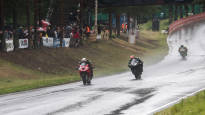The fifth fatal accident in all of the Imatra races raises a debate about the safety of the sport and the motorcycle race on the Imatra street track.
On Sunday, in a traditional event, a 30-year-old Dutch driver Joey den Besten crashed his motorcycle during the warm-up round of the IRRC Superbike series and died at the scene.
Experienced Finnish drivers Juha Kallio and Timo Paavilainen emphasize that motorcycling and especially its street series involve special risks.
Kallio and Paavilainen have participated in the Imatranajai several times. Kallio was also present at this year’s event and he has talked with the drivers who took part in the competition.
– The saddest thing is that it is a place where this should not have happened, says Kallio.
– Where the accident happened, it is very straight and the road turns gently to the right.
Because of this, no special attention was paid to safety in the vicinity of the accident site either. In Imatra, the situation was also affected by the conditions, which were challenging due to the rain.
– In such situations, water is poison and in the end games it is difficult to know what has happened in it. That is in no way a supposed place where something like this could happen at all, says Kallio.
The last fatal accident occurred in Imatranajai in 2019, when the weather conditions were also rainy.
There is no point in speculating about the situation
Kallio met den Besten, who died in an accident, in the spring in Holland. Den Besten was excited about the Imatra competition.
– It’s always touching when familiar friends leave.
– He was a driver who has been driving for a long time. He raced street tracks long before the Imatra competition of this format, for example, existed, so he knew what he was getting into.
The Imatra races have been on the race calendar of the international IRRC track motorcycle series since 2016. In the years 1964–1982 and in 1986, the races were held in the World Series of the sport.
Kallio points out that it is not customary to look for culprits in the sport and, according to him, it is pointless. Especially when the investigation into the accident is still ongoing.
– It’s more like honoring the memory of the driver, in this case Joey. Events are not terribly speculated, because sometimes in the sport there are cases where the driver has made a mistake or, for example, the mechanic has made a mistake.
Kallio emphasizes that the sport is not sports entertainment, but rather a hobby for people, which is comparable to other extreme sports such as skydiving. Timo Paavilainen, who ended his racing career in 2016, points out the same. Paavilainen specializes in long 24-hour races, where driving at night brings its own risks.
Danger is a mandatory part of the sport
Chairman of the board of Imatranajo Marjaana Pakkanen according to Imatra’s street track is one of the safest street track series competitions. Paavilainen and Kallio agree.
They also emphasize that participation in the competition is always a voluntary choice of the driver. It is impossible to exclude all risks, but the competitors always know where they are coming and are aware of the risks.
– You always think about the reasonableness of the matter, but my own opinion is that the drivers themselves decide. The organizers must then make the framework as safe as possible and carry out the competition as well as possible, says Kallio.
It is impossible to make street motorcycle riding safe, and the speed in competitions is often over 200 kilometers per hour. At Imatra, efforts have been made to improve the safety of the public and competitors, for example by using fences. In addition, the lampposts are protected during the competition.
In 2011, Paavilainen, who was seriously injured in the 24-hour race at Le Mans in France, emphasizes that sudden crashes and obstacles near the track create danger in the sport – not the speed itself.
– Speeds have increased when the power of the engines has increased, but correspondingly, deceleration bends, three pieces of chicanes have been made on the track, so that the speed does not increase higher than it is now, says Paavilainen.
According to Paavilainen, the competition will not be canceled in the future and it is justified to hold the event if drivers sign up and the public arrives.
In the interview, Pakkanen brought up the grooves formed on the track during the winter, which collect water. At the moment, according to Kallio, the causes of the accident can only be considered.
– We will certainly think about it in the future, what can be done to such a place and, for example, to the uri. I know that much, from having raced myself in the past and driving in the rain, that grooves are challenging places. Of course, we try to avoid that and hydroplaning in competitions, says Kallio.
